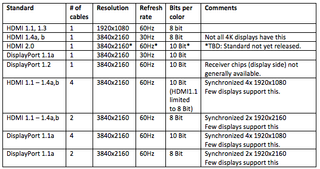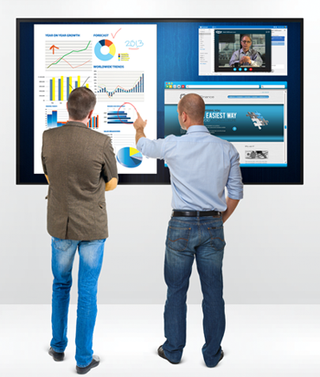Steve Seminario, Planar Systems

Connecting a 4K (3840 x 2160) resolution source to a 4K display typically involves some combination of HDMI and DisplayPort connections. In both cases, the version of the standard implemented is a critical factor in the display’s ability to receive a 4K signal over a single connection. The table below summarizes the capacity, in terms of resolution, refresh rate and color depth that the various HDMI and DisplayPort standards can support. As an alternative to single link 4k connections, some displays are able to receive a synchronized group of 2 or 4 connections in order to process and display a 4K source.


Connecting a 4K (3840 x 2160) resolution source to a 4K display typically involves some combination of HDMI and DisplayPort connections. Shown here, Planar’s UltraRes Series 4K LCD display.
- While it would be ideal to be able to take a full 60Hz 4K signal with 10 bit color over a single connection, the implementations are really not there yet today, and practically speaking, slower refresh rates and multi-connection configurations that are available, generate excellent 4k results with most content.
- With today’s graphics cards, content servers and video processors supporting a combination of HDMI, DVI, SDI and DisplayPort outputs, it is not uncommon to have to covert one signal type to another. Luckily, there are converters available today and those choices continue to grow in the market. A key factor in a converter is whether it can be passive, in which case it will be a compact device requiring no external power, or if on the other hand it is active (or “powered”), in which case it will be larger and will require a power source and typically be more expensive. The table below outlines these converters.
Cable length is another factor. The HDMI and DisplayPort standards do not specify a maximum cable length, so testing and experimentation is required. In our experience, using good quality cables, we have been able to successfully support:

* Informal testing results.
Extenders are available in the market for both HDMI and DisplayPort, but today there are certainly more choices available for HDMI because of its widespread use. Extenders utilizing coax, HDBaseT and fiber cabling support different run distances and are priced accordingly.
In 4K connectivity the other area of rapid development is around network connectivity. For network streaming of 4K, the H.265 HEVC (High Efficiency Video Coding) draft standard approved in July 2012 has set about a flurry of industry development, particularly related to the broadcast industry. Designed with 4K and 8K resolutions in mind, the H.265 HEVC standard promises to double the compression efficiency of H.264 encoding broadly used today. At the NAB show this past April a number of companies discussed or demonstrated prototype implementations. While IP network transport of 4K video is not here yet, it’s a solution that has a lot of momentum behind it from the broadcast TV world.










